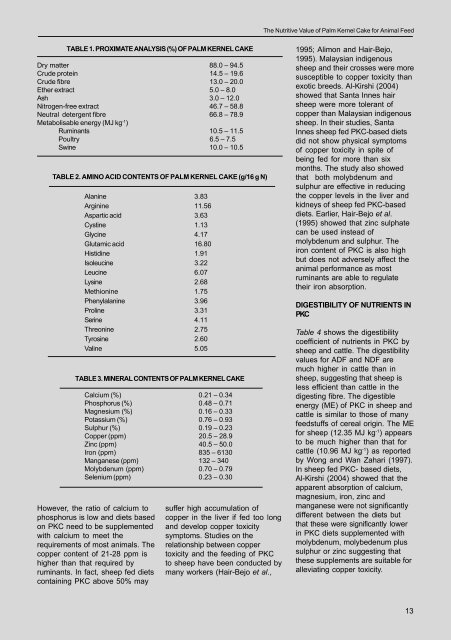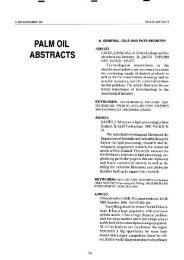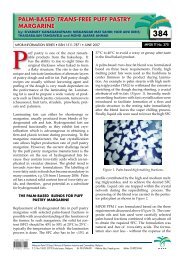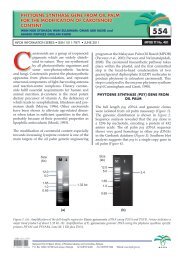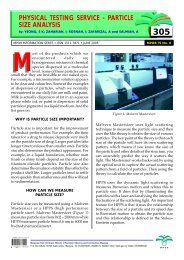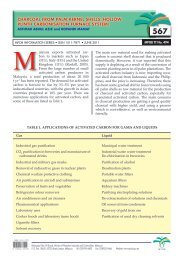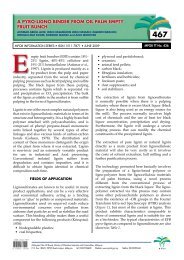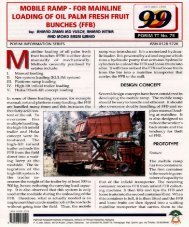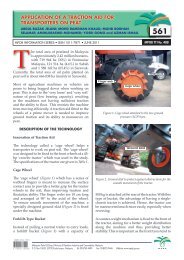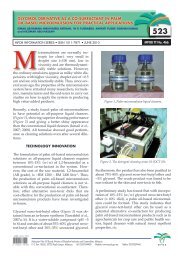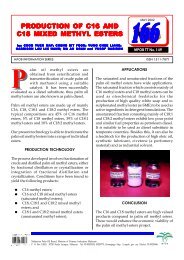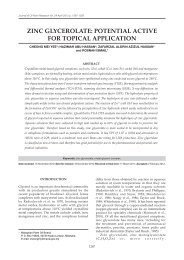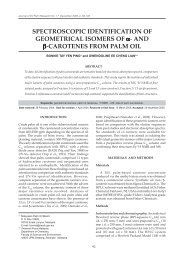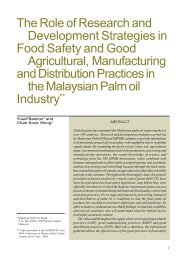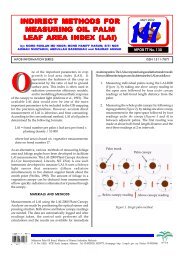The Nutritive Value of Palm Kernel Cake for Animal Feed
The Nutritive Value of Palm Kernel Cake for Animal Feed
The Nutritive Value of Palm Kernel Cake for Animal Feed
Create successful ePaper yourself
Turn your PDF publications into a flip-book with our unique Google optimized e-Paper software.
TABLE 1. PROXIMATE ANALYSIS (%) OF PALM KERNEL CAKE<br />
Dry matter 88.0 – 94.5<br />
Crude protein 14.5 – 19.6<br />
Crude fibre 13.0 – 20.0<br />
Ether extract 5.0 – 8.0<br />
Ash 3.0 – 12.0<br />
Nitrogen-free extract 46.7 – 58.8<br />
Neutral detergent fibre 66.8 – 78.9<br />
Metabolisable energy (MJ kg -1 )<br />
Ruminants 10.5 – 11.5<br />
Poultry 6.5 – 7.5<br />
Swine 10.0 – 10.5<br />
TABLE 2. AMINO ACID CONTENTS OF PALM KERNEL CAKE (g/16 g N)<br />
Alanine 3.83<br />
Arginine 11.56<br />
Aspartic acid 3.63<br />
Cystine 1.13<br />
Glycine 4.17<br />
Glutamic acid 16.80<br />
Histidine 1.91<br />
Isoleucine 3.22<br />
Leucine 6.07<br />
Lysine 2.68<br />
Methionine 1.75<br />
Phenylalanine 3.96<br />
Proline 3.31<br />
Serine 4.11<br />
Threonine 2.75<br />
Tyrosine 2.60<br />
Valine 5.05<br />
TABLE 3. MINERAL CONTENTS OF PALM KERNEL CAKE<br />
Calcium (%) 0.21 – 0.34<br />
Phosphorus (%) 0.48 – 0.71<br />
Magnesium (%) 0.16 – 0.33<br />
Potassium (%) 0.76 – 0.93<br />
Sulphur (%) 0.19 – 0.23<br />
Copper (ppm) 20.5 – 28.9<br />
Zinc (ppm) 40.5 – 50.0<br />
Iron (ppm) 835 – 6130<br />
Manganese (ppm) 132 – 340<br />
Molybdenum (ppm) 0.70 – 0.79<br />
Selenium (ppm) 0.23 – 0.30<br />
However, the ratio <strong>of</strong> calcium to<br />
phosphorus is low and diets based<br />
on PKC need to be supplemented<br />
with calcium to meet the<br />
requirements <strong>of</strong> most animals. <strong>The</strong><br />
copper content <strong>of</strong> 21-28 ppm is<br />
higher than that required by<br />
ruminants. In fact, sheep fed diets<br />
containing PKC above 50% may<br />
suffer high accumulation <strong>of</strong><br />
copper in the liver if fed too long<br />
and develop copper toxicity<br />
symptoms. Studies on the<br />
relationship between copper<br />
toxicity and the feeding <strong>of</strong> PKC<br />
to sheep have been conducted by<br />
many workers (Hair-Bejo et al.,<br />
<strong>The</strong> <strong>Nutritive</strong> <strong>Value</strong> <strong>of</strong> <strong>Palm</strong> <strong>Kernel</strong> <strong>Cake</strong> <strong>for</strong> <strong>Animal</strong> <strong>Feed</strong><br />
1995; Alimon and Hair-Bejo,<br />
1995). Malaysian indigenous<br />
sheep and their crosses were more<br />
susceptible to copper toxicity than<br />
exotic breeds. Al-Kirshi (2004)<br />
showed that Santa Innes hair<br />
sheep were more tolerant <strong>of</strong><br />
copper than Malaysian indigenous<br />
sheep. In their studies, Santa<br />
Innes sheep fed PKC-based diets<br />
did not show physical symptoms<br />
<strong>of</strong> copper toxicity in spite <strong>of</strong><br />
being fed <strong>for</strong> more than six<br />
months. <strong>The</strong> study also showed<br />
that both molybdenum and<br />
sulphur are effective in reducing<br />
the copper levels in the liver and<br />
kidneys <strong>of</strong> sheep fed PKC-based<br />
diets. Earlier, Hair-Bejo et al.<br />
(1995) showed that zinc sulphate<br />
can be used instead <strong>of</strong><br />
molybdenum and sulphur. <strong>The</strong><br />
iron content <strong>of</strong> PKC is also high<br />
but does not adversely affect the<br />
animal per<strong>for</strong>mance as most<br />
ruminants are able to regulate<br />
their iron absorption.<br />
DIGESTIBILITY OF NUTRIENTS IN<br />
PKC<br />
Table 4 shows the digestibility<br />
coefficient <strong>of</strong> nutrients in PKC by<br />
sheep and cattle. <strong>The</strong> digestibility<br />
values <strong>for</strong> ADF and NDF are<br />
much higher in cattle than in<br />
sheep, suggesting that sheep is<br />
less efficient than cattle in the<br />
digesting fibre. <strong>The</strong> digestible<br />
energy (ME) <strong>of</strong> PKC in sheep and<br />
cattle is similar to those <strong>of</strong> many<br />
feedstuffs <strong>of</strong> cereal origin. <strong>The</strong> ME<br />
<strong>for</strong> sheep (12.35 MJ kg -1 ) appears<br />
to be much higher than that <strong>for</strong><br />
cattle (10.96 MJ kg -1 ) as reported<br />
by Wong and Wan Zahari (1997).<br />
In sheep fed PKC- based diets,<br />
Al-Kirshi (2004) showed that the<br />
apparent absorption <strong>of</strong> calcium,<br />
magnesium, iron, zinc and<br />
manganese were not significantly<br />
different between the diets but<br />
that these were significantly lower<br />
in PKC diets supplemented with<br />
molybdenum, molybedenum plus<br />
sulphur or zinc suggesting that<br />
these supplements are suitable <strong>for</strong><br />
alleviating copper toxicity.<br />
13


